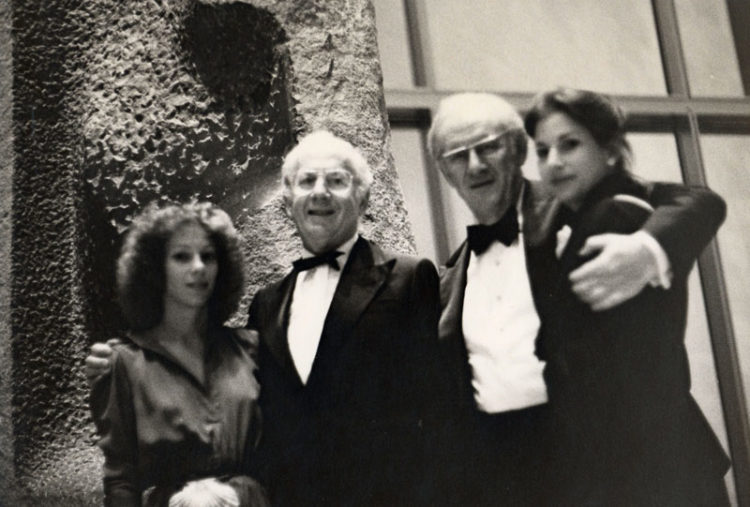The Jewish Family Behind the Opioid Addiction Crisis in North America
by Karl Radl
A SPECTER is haunting America.
The specter of opium.
The form that specter is taking is that of the opiate-based painkiller OxyContin, which is distributed by a company named Purdue Pharma. There has long been a concern that OxyContin is causing an addiction time bomb in America, especially among the White working class. (1)
To quote Christopher Glazek:
According to the Centers for Disease Control, fifty-three thousand Americans died from opioid overdoses in 2016, more than the thirty-six thousand who died in car crashes in 2015 or the thirty-five thousand who died from gun violence that year. This past July, Donald Trump’s Commission on Combating Drug Addiction and the Opioid Crisis, led by New Jersey governor Chris Christie, declared that opioids were killing roughly 142 Americans each day, a tally vividly described as “September 11th every three weeks.” The epidemic has also exacted a crushing financial toll: According to a study published by the American Public Health Association, using data from 2013 — before the epidemic entered its current, more virulent phase — the total economic burden from opioid use stood at about $80 billion, adding together health costs, criminal-justice costs, and GDP loss from drug-dependent Americans leaving the workforce. Tobacco remains, by a significant multiple, the country’s most lethal product, responsible for some 480,000 deaths per year. (2)
And to confirm the impression, I quote the Los Angeles Times’ May 2016 exposé on the OxyContin crisis gripping the country:
Over the last 20 years, more than 7 million Americans have abused OxyContin, according to the federal government’s National Survey on Drug Use and Health. The drug is widely blamed for setting off the nation’s prescription opioid epidemic, which has claimed more than 190,000 lives from overdoses involving OxyContin and other painkillers since 1999. (3)
The scale of this crisis is indeed vast: Why don’t we hear more about this crisis or the people who created it?
The answer is very simple: The owners of Purdue Pharma are not some amorphous corporate entity, but rather a single family: the Sacklers.
The Sacklers, a Jewish family originally from Poland, trace their wealth to the three Sackler brothers: Arthur, Mortimer and Raymond. In 1952, the brothers purchased the ailing patent medicine company Purdue and began to develop and ruthlessly promote controversial mass-market pharmaceuticals to American doctors. (4)
Arthur Sackler was, along with his two psychiatrist brothers, a long-time devotee of Sigmund Freud. (5) It was Arthur who first laid the foundation of the Sackler family fortune with the famous anti-anxiety drug Valium.
To quote Glazek once more:
In the 1960s, Arthur was contracted by Roche to develop an advertising strategy for a new anti-anxiety medication called Valium. This posed a challenge, because the effects of the medication were nearly indistinguishable from those of Librium, another Roche tranquilizer that was already on the market. Arthur differentiated Valium by audaciously inflating its range of indications. Whereas Librium was sold as a treatment for garden- variety anxiety, Valium was positioned as an elixir for a problem Arthur christened “psychic tension.” According to his ads, psychic tension, the forebear of today’s “stress,” was the secret culprit behind a host of somatic conditions, including heartburn, gastrointestinal issues, insomnia, and restless-leg syndrome. The campaign was such a success that for a time Valium became America’s most widely prescribed medication — the first to reach more than $100 million in sales. Arthur, whose compensation depended on the volume of pills sold, was richly rewarded, and he later became one of the first inductees into the Medical Advertising Hall of Fame. (6)
Patrick Redden Keefe in the New Yorker writes similarly that:
During the sixties, Arthur got rich marketing the tranquillizers Librium and Valium. One Librium ad depicted a young woman carrying an armload of books, and suggested that even the quotidian anxiety a college freshman feels upon leaving home might be best handled with tranquillizers. Such students “may be afflicted by a sense of lost identity,” the copy read, adding that university life presented “a whole new world . . . of anxiety.” The ad ran in a medical journal. Sackler promoted Valium for such a wide range of uses that, in 1965, a physician writing in the journal Psychosomatics asked, “When do we not use this drug?” One campaign encouraged doctors to prescribe Valium to people with no psychiatric symptoms whatsoever: “For this kind of patient — with no demonstrable pathology — consider the usefulness of Valium.” Roche, the maker of Valium, had conducted no studies of its addictive potential. Win Gerson, who worked with Sackler at the agency, told the journalist Sam Quinones years later that the Valium campaign was a great success, in part because the drug was so effective. “It kind of made junkies of people, but that drug worked,” Gerson said. By 1973, American doctors were writing more than a hundred million tranquillizer prescriptions a year, and countless patients became hooked. The Senate held hearings on what Edward Kennedy called “a nightmare of dependence and addiction.” (7)
In essence, then, Arthur Sackler was a conman with a somewhat effective, highly addictive product that — like any good snake oil salesman — he proclaimed would cure any illness. It was with the appearance of OxyContin, however, that this synthesis of callousness and ruthless greed would reach its blood-soaked apogee.
It all started out in 1989 with a new wave of skepticism about the concepts of physical addiction and dependence, a skepticism which the Sacklers had long promoted and continue to use as their primary defense against charges made against them. (8) This skepticism led many medical doctors at that time to revisit and revise their previous negative opinion of opioid-based painkillers. Capitalizing on this shift in perception, Purdue Pharma pushed a new opioid-based painkiller — OxyContin — onto the market in 1995. Raymond Sackler’s son Richard
…worked tirelessly to make OxyContin a blockbuster, telling colleagues how devoted he was to the drug’s success. The F.D.A. approved OxyContin in 1995, for use in treating moderate to severe pain. Purdue had conducted no clinical studies on how addictive or prone to abuse the drug might be. But the F.D.A., in an unusual step, approved a package insert for OxyContin which announced that the drug was safer than rival painkillers, because the patented delayed-absorption mechanism “is believed to reduce the abuse liability.” David Kessler, who ran the F.D.A. at the time, told me that he was “not involved in the approval.” The F.D.A. examiner who oversaw the process, Dr. Curtis Wright, left the agency shortly afterward. Within two years, he had taken a job at Purdue. (9)
This designation was ludicrous, especially in light of information about OxyContin’s abuse potential that was already known at the time:
The theory was that addicts would shy away from timed-released drugs, preferring an immediate rush. In practice, OxyContin, which crammed a huge amount of pure narcotic into a single pill, became a lusted-after target for addicts, who quickly discovered that the timed-release mechanism in OxyContin was easy to circumvent — you could simply crush a pill and snort it to get most of the narcotic payload in a single inhalation. This wasn’t exactly news to the manufacturer: OxyContin’s own packaging warned that consuming broken pills would thwart the timed-release system and subject patients to a potentially fatal overdose. MS Contin had contended with similar vulnerabilities, and as a result commanded a hefty premium on the street. But the “reduced abuse liability” claim that added wings to the sales of OxyContin had not been approved for MS Contin. It was removed from OxyContin in 2001 and would never be approved again for any other opioid. (10)
As both Keefe and Glazek imply, (10) it is likely that Dr. Curtis Wright had been corrupted by the Sackler family. This assertion is further supported by the extraordinary permission allotted to the Sacklers and Purdue Pharma to market OxyContin as if it had been medically proven to be the most effective product on the market.

This was only the start, however, as Glazek writes further:
By 2001, annual OxyContin sales had surged past $1 billion. Sales reps were encouraged to downplay addiction risks. “It was sell, sell, sell,” recalled Sherman. “We were directed to lie. Why mince words about it? Greed took hold and overruled everything. They saw that potential for billions of dollars and just went after it.” Flush with cash, Purdue pioneered a high-cost promotion strategy, effectively providing kickbacks — which were legal under American law — to each part of the distribution chain. Wholesalers got rebates in exchange for keeping OxyContin off prior authorization lists. Pharmacists got refunds on their initial orders. Patients got coupons for thirty-day starter supplies. Academics got grants. Medical journals got millions in advertising. Senators and members of Congress on key committees got donations from Purdue and from members of the Sackler family.
It was doctors, though, who received the most attention. “We used to fly doctors to these ‘seminars,’ ” said Sherman, which were, in practice, “just golf trips to Pebble Beach. It was graft.” Though offering perks and freebies to doctors was hardly uncommon in the industry, it was unprecedented in the marketing of a Schedule II narcotic. For some physicians, the junkets to sunny locales weren’t enough to persuade them to prescribe. To entice the holdouts — a group the company referred to internally as “problem doctors” — the reps would dangle the lure of Purdue’s lucrative speakers’ bureau. “Everybody was automatically approved,” said Sherman. “We would set up these little dinners, and they’d make their little fifteen-minute talk, and they’d get $500.
Between 1996 and 2001, the number of OxyContin prescriptions in the United States surged from about three hundred thousand to nearly six million, and reports of abuse started to bubble up in places like West Virginia, Florida, and Maine. (Research would later show a direct correlation between prescription volume in an area and rates of abuse and overdose.) Hundreds of doctors were eventually arrested for running pill mills. According to an investigation in the Los Angeles Times, even though Purdue kept an internal list of doctors it suspected of criminal diversion, it didn’t volunteer this information to law enforcement until years later.’ (11)
This in itself should have been criminal. However, Purdue avoided charges due to a mix of poor legislative oversight and corporate malfeasance. They also benefited from some brand confusion on the part of Americans, as Glazek once again describes:
A common malapropism led to further advantage for Purdue. “Some people would call it oxy-codeine” instead of oxycodone, recalled Lacouture. “Codeine is very weak.” When Purdue eventually pleaded guilty to felony charges in 2007 for criminally “misbranding” OxyContin, it acknowledged exploiting doctors’ misconceptions about oxycodone’s strength. In court documents, the company said it was “well aware of the incorrect view held by many physicians that oxycodone was weaker than morphine” and “did not want to do anything ‘to make physicians think that oxycodone was stronger or equal to morphine’ or to ‘take any steps . . . that would affect the unique position that OxyContin’” held among physicians.
Unsurprisingly, unscrupulous sales and marketing tactics like this led to Purdue Pharma eventually being fined $600 million in 2007 for lying to doctors about the potential for patients to abuse OxyContin. Purdue was fully aware of this issue, but had deliberately suppressed this information to prevent a drop in sales. (12) Purdue Pharma also went to great lengths to protect the Sackler family, as no family members were named in the law suit. This was despite Richard Sackler’s — and indeed the whole extended family’s — close involvement with Purdue Pharma, including launching and pushing its best-selling product, the source of their $14 billion fortune: OxyContin. (13, 14)
As Glazek rightly observes:
Few are aware that during the crucial period of OxyContin’s development and promotion, Sackler family members actively led Purdue’s day-to-day affairs, filling the majority of its board slots and supplying top executives. By any assessment, the family’s leaders have pulled off three of the great marketing triumphs of the modern era: The first is selling OxyContin; the second is promoting the Sackler name; and the third is ensuring that, as far as the public is aware, the first and the second have nothing to do with one another. (15)
If the Sackler family was as innocent as they like to claim then — as Keith Humphreys has observed — they wouldn’t have gone to such extraordinary lengths to distance themselves from their product.
To quote Humphreys:
The Sacklers have hidden their connection to their product. They don’t call it ‘Sackler Pharma.’ They don’t call their pills ‘Sackler pills.’ And when they’re questioned, they say, ‘Well, it’s a privately held firm, we’re a family, we like to keep our privacy, you understand.’ (16)
The family are clearly concerned about the impact of having their name linked with a highly addictive mass-marketed opioid-based painkiller, which is being linked to depression and suicide across North America at a level on par with ethnic cleansing. (17)
The fact that — as previously alluded to — the drug was, and is, primarily being prescribed to working class White Americans should tell you everything you need to know about the Jewish billionaires that are the Sackler family.
References
(1) http://www.breitbart.com/big-government/2017/11/20/princeton-scholars-opioid-crisis-alcoholism-suicide-to-blame-for-rising-white-working-class-mortality-rate/ ; https://www.bloomberg.com/news/articles/2017-03-23/white-working-class-death-rate-to-be-elevated-for-a-generation ; https://www.theatlantic.com/education/archive/2017/03/the-collapse-of-the-white-working-class/520815/ ; https://www.washingtonpost.com/news/the-fix/wp/2017/10/26/the-opioid-crisis-isnt-limited-to-white-americans-in-rural-pro-trump-counties/?utm_term=.c2c6bcc796eb ; https://www.economist.com/news/united-states/21721960-deaths-drugs-say-more-about-markets-about-white-despair-inside-opioid
(2) http://www.esquire.com/news-politics/a12775932/sackler-family-oxycontin/
(3) Ibid; http://www.latimes.com/projects/oxycontin-part1/
(4) http://forward.com/fast-forward/385375/the-Jewish-family-making-billions-from-the-opioid-crisis/
(5) http://www.latimes.com/projects/oxycontin-part1/
(6) http://www.esquire.com/news-politics/a12775932/sackler-family-oxycontin/
(7) https://www.newyorker.com/magazine/2017/10/30/the-family-that-built-an-empire-of-pain
(8) Ibid; http://www.esquire.com/news-politics/a12775932/sackler-family-oxycontin/
(9) https://www.newyorker.com/magazine/2017/10/30/the-family-that-built-an-empire-of-pain
(10) http://www.esquire.com/news-politics/a12775932/sackler-family-oxycontin/
(11) Ibid.; also http://forward.com/fast-forward/385375/the-Jewish-family-making-billions-from-the-opioid-crisis/ and http://www.latimes.com/projects/oxycontin-part1/
(12) http://forward.com/fast-forward/385375/the-Jewish-family-making-billions-from-the-opioid-crisis/ ; http://www.esquire.com/news-politics/a12775932/sackler-family-oxycontin/ ; https://www.newyorker.com/magazine/2017/10/30/the-family-that-built-an-empire-of-pain
(13) Ibid.
(14) http://www.esquire.com/news-politics/a12775932/sackler-family-oxycontin/
(15) Ibid.
(16) Ibid.
(17) Ibid; http://www.latimes.com/projects/oxycontin-part1/
* * *
Source: The Purity Spiral







Hitler was so right: if you cut cautiously into any human abscess, you’ll often find a Jew.
White nationalists better be ready to argue cases like this. Were the Sacklers that different from the white producers and marketers of cigarettes, when their ads in the 1940s to the 1960’s showed doctors smoking them after internal evidence had accrued that smoking was harmful? Random references: https://drugfree.org/learn/drug-and-alcohol-news/tobacco-companies-hid-dangers-of-cigarette-substance-for-decades/ and https://en.wikipedia.org/wiki/American_Tobacco_Company. The answer is that the jews have made public humanitarianism their thing, the way whites made building modern societies and feeding the world, its. What does it say when one of these humanitarian families knowingly pedals dope on a mass scale, and instead of contrition and redirected humanitarianism when exposed, throws up legal roadblocks ? Another area concerns the jewsmedia, which we attribute to controlling the popular news services, but since at least 2014 has reported on who control Purdue… Read more »
Hitler was so right as were many on the jewish question. I hate them and pray everyday for their removal from this earth! People need to awaken to this Jewish disease.
You mention Valium. My father was taking large quantities in 1969 for a stomach ulcer and committed suicide. Stephen Paddock, the Las Vegas shooter, was on Valium. The problem isn’t the drug itself, but the false advertisement and coverups. Oxycontin should only be used for someone with terminal cancer, but it wound up on the streets.
Like George Soros, the Sacklers have been called “philanthropists,” although they really should be designated “enemies of mankind” (hostis humani generis) and treated accordingly.
One wonders how many lives one has to ruin, how many deaths one has to cause, how many “colored revolutions” one has to bankroll with ill-gotten money in order to qualify as a “philanthropist.”
Come to think of it, there was once such a thing as the Stalin Peace Prize, although its formal name was the “International Stalin Prize for Strengthening Peace Among Peoples,” and it was later renamed the “International Lenin Prize for Strengthening Peace Among Peoples.” Apparently Nelson Mandela was the last person to be awarded this prize.
Excellent article! Purdue Pharma’s fraudulent-marketing federal conviction in 2007 for 1995-2001 was reported at http://www.nytimes.com/2007/05/10/business/11drug-web.html . However, the article does not mention the Sacklers, but calls the ownership “closely held”. Did they have a rabbi at the Times, or was it the Sackler’s supposed cultural influence that could pad its Arts and Leisure section? Many states have sued Purdue too. However, no Sackler has had to testify under oath in any case, except for Richard in Kentucky’s civil suit, but that testimony is blocked from public release supposedly due to the legal settlement with Purdue, as per https://www.statnews.com/2016/03/15/stat-seeks-oxycontin-records/ . Not surprising, since instead of facing the music and trying to explain its insular, alien position toward its consumers (and survivors of ), Purdue lawyers had pulled every legal trick they… Read more »
There have been men of various faiths(and atheists and agnostics) commit crimes against humanity. To single out Judaism as the possible motivation of THIS crime against humanity is wrong. Human beings can screw up a two car funeral…meaning it can be a cruel world. That doesn’t legitimized crimes against humanity….it means I had better educate myself AND learn critical thinking skills in order to protect myself.
Mr. Blair M. Phillips
Canada
In his comment, Blair Phillips advocates educating oneself and applying critical thinking skills, but he evidently doesn’t practice these things himself. He simply parrots mushy platitudes, the subtext of which is the following: “bad things happen, we shouldn’t ask why they happen, we shouldn’t ask who is responsible for them, we shouldn’t seek to punish those responsible, we should turn the other cheek, we’re all guilty of everything.” Otherwise, we might be guilty of “scapegoating,” “anti-Semitism,” and “neo-Nazism.” Phillips comes across as the kind of person who thinks that Jews who do bad things to our people “just happen” to be Jews (something that “just happens” with suspicious if not alarming frequency), and that the peculiar religion and culture of the Jews has nothing to do with their bad conduct.… Read more »
If it’s a skunk then call it a skunk. The Jews have been kicked out of every entire country they have ever entered.The great usa kicked them out twice! The were behind the mid-atlantic slave trade,big pharma, every entire war; they are the inventors of porno. They promote everything that’s wrong in every nation all for a shekel. If you ever read the talmud you wouldn’t be defending them. They say in the talmud that a 50 year old jew can have sex with a 3 year old non-jew and that its ok, in fact its fine and no punishment. Now if that’s ok with you, you yourself are SICK!!! I bet you’re the kinda person though that hates muslims and call them terrorists. The jews deserve everything and anything… Read more »
Indeed. Mr. Blair Phillips either does not know much about the well earned reputation of Jewish people or he does know a lot about what their reputation has been for hundreds of years and is trying to cover that over like a cat in a litter box.